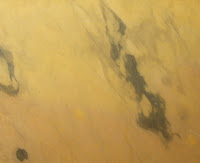I got this stone a short while ago, but it has been just sitting there while I have been too busy finishing other projects. Finally, I got the time to give it a go. The stone looks like compacted very fine sand. A greenish golden sandy colour (kiita) with small spots and su holes. The stone has a very nice chiseled back side and showing a very nice dark rusty brown skin. The surface is absolutely clean with no cracks or lines or inclusions of any kind. It is a truly beautiful stone.
The Takashima stones come from the Shiga prefecture in Japan. The Takashima mine is still open, but due to mining restrictions it is not actively mined. This means that even if the mine and stones still exist, only old stock stones are sold. They are still available in the market, but you will have to be prepared to fork up $200-300 for a nice piece.
The Takashima stones come from the Shiga prefecture in Japan. The Takashima mine is still open, but due to mining restrictions it is not actively mined. This means that even if the mine and stones still exist, only old stock stones are sold. They are still available in the market, but you will have to be prepared to fork up $200-300 for a nice piece.
The chiseling shows that this is probably a fairly soft stone, which would suggest it is not one of the finest grit stones. Still, looking at the below pictures it looks very uniform and even throughout the stone, and I was very excited about putting it to the test. The softer Takashima is said to be excellent with Honyaki, so I picked that out for the test as well in addition to my trusty Kasahara Honkasumi Usuba.
The pictures below show the black metal filings after 10 strokes with the Usuba kasumi. As you can see it is not the most agressive stone, but this is actually the whole point about this stone. Slow grinding, controlled and very even, making a perfect pre-polish grind with very homogenous, dense and shallow grind marks. And it is so easy to use that even the novice sharpener can get a pretty good result.
The next picture shows the dense creamy slurry after about 50 passes with the Usuba. As you can see the slurry is only lightly coloured by the black metal which means the stone gives up a lot of material making up the creamy slurry. This again makes for a very delicate feel when sharpening. The stone was really thirsty, so I had to spray it quite often with water. After working the stone for a while it seemed to saturate with water, easing up the sharpening process a lot. I believe a 10 minute soaking will do the trick.
Looking at the result, you can see that the Takashima leaves a very even and dense scratch pattern. This is the perfect starting point for the finishing stones. I felt that after a 150-200 strokes on the Takashima after the Aoto, the edge got a lot more refined after finishing on the Oohira Asagi or even the Oohira Shiro Suita than when finishing directly from the Aoto.
You can also see the beautiful dense scratch pattern thie Takashima leaves on the blade road of my Shiroko Honyaki yanagiba. I experienced the same thing with Honyakt that I did with the Honkasumi. The edge got very refined from the Takashima making it a breeze to finish it on my Nakayama.
This stone is a typical team player. It is not coarse nor agressive enough to be your only medium sharpener or fine enough to be your final finisher. What the Takashima Myokakudani does is to refine the surfaces and the edge from your medium sharpener and priming the edge for the final finishing stone. This task it does to perfection. After using the Takashima I could get especially the Honyaki exceptionally sharp and refined. It really stuck to my nail.
The stone does pretty much the same work as the Oohira Asagi as a pre finisher, but due to its softer feel, it is a lot easier to use and gives the unexperienced knife sharpener a better feeling of what the stone actually does to the steel.
I can recommend this stone to the novice sharpener as well as anyone serious about sharpening Honyaki or even high quality kasumi knives. The work it does to prepare the surfaces to the final finisher saves you a lot of time and finishing stone, and to my experience actually gives you an even better final result.

























































